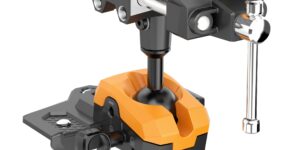DECIDING ON THE RIGHT SHEET AND PLATE CUTTING PROCESS
When investing in new CNC sheet or plate contour cutting equipment, which process will best cover all of the requirements? Jim Colt of Hypertherm explores how the answer lies in knowing how to use plasma, oxy-fuel, laser, or abrasive waterjet processes most effectively.
Posted: December 22, 2011
Productivity can even be achieved with some processes that have low cutting speeds. Consider oxy-fuel as an example: 12 oxy-fuel torches cutting simultaneously will cut 1 in thick steel parts faster than any of the other processes (using one cutting head). So from a productivity point of view there can be more than one process listed that has the advantage.
Plasma. This is the fastest process on all metals from ¼ in through 2 in, based on a single cutting head vs. one competitive process cutting head. To dramatically improve throughput, mounting two plasma torches on a single gantry CNC machine is relatively common, and even mounting four plasma torches on a single gantry is a little less common. Because of the ability to cut materials very fast, the plasma is generally the productivity winner on materials thicker than ¼ in.
The rule of thumb on the comparison with oxy-fuel is this: one high definition plasma torch will cut as many parts as six oxy-fuel torches. Cost per part in the ¼ in to 2 in range is generally lowest with the plasma cutting process. Cut part accuracy can typically be expected to be within about ± .015 in on most materials under 1 in thick with a high definition class plasma system. This number, of course, can vary depending on the type and condition of equipment.
Laser is the most productive process on most materials thinner than ¼ in. This material range is also an area where the laser excels in terms of cut part accuracy. Cost per foot of cut on steel is usually similar or slightly more costly as compared to plasma in the under ¼ in thickness range. However, on aluminum and stainless the laser’s higher gas flow rates typically push the cost per foot of cut much higher that the plasma process. In the lasers best thickness range it is not uncommon to hold tolerances in the ± .008 in cut part accuracy range.
Oxy-fuel is the only process that can cut materials thicker than 2 in on a productive basis. Abrasive waterjet can cut in this thickness range, but at even slower cut speeds and much higher operating costs. There are some cases, as mentioned previously, where an oxy-fuel machine with multiple torches can be more productive than plasma. But based on the amount of heavy steel that needs to be cut, as well as the ability to economically add oxy-fuel torches to a plasma CNC machine, oxy-fuel is here to stay.
Many shops with older plasma technology switch over to oxy-fuel once the steel thickness approaches ¾ in. With newer technology plasma that has the ability to pierce 2 in steel, oxy-fuel is often used only when multiple torches will provide an advantage or for material that is thicker than the installed plasma can cut. Cost per foot of cut can be advantageous on thicker materials or when multiple torches are used. Typical cut part tolerances with oxy-fuel can be in the ± .030 in range, depending upon the motion control equipment being used.
Abrasive waterjet has the pure advantage of being able to cut almost anything. This advantage may not be useful to just any shop, but it certainly becomes an advantage when the shop needs a diverse materials list. During the economic downturn I saw more than one waterjet in a metal fab shop cutting non-metal materials to keep busy!
In reality, while the waterjet is generally a less productive process from a cutting speed point of view, if highly accurate parts are required with a non-heat affected cut edge, such as in aerospace, special welding processes, etc., then the waterjet is the best choice. Waterjet also has an advantage on thick materials such as aluminum and stainless over ¾ in because the process can produce cleaner, squarer edges as compared to plasma.
The parts may be costlier and slower to cut, but they will require less in terms of secondary operations to bring them within the tolerance levels that may be required. Cost per foot of cut is typically highest with an abrasive waterjet cutting process. Abrasive waterjet tolerances are similar to laser tolerances on materials thinner than 3/8 in and can approach plasma tolerances on thicker materials.
SUMMARY
While I have to admit to many generalized statements in the comparisons above, the reality of the matter is that there are many manufacturers of the above processes, and each one has their own unique technologies and product variations. In order to place metrics (actual cut speeds, cut tolerances, cost per foot) that are an accurate representation on all of the available technologies into a single document would require years of research and data gathering. By the time the project was actually completed, new developments would likely make the data obsolete!
The bottom line is this: There is no one plate/sheet cutting process for the metal fabricating industry that will best support all materials and thicknesses in all ways. The best choice is made by listening to the person that is using the finished metal part – What are his most important factors? Cost? Cut part tolerance? Perfect base metal metallurgy?
The best process must be chosen from the end customer’s criteria.










